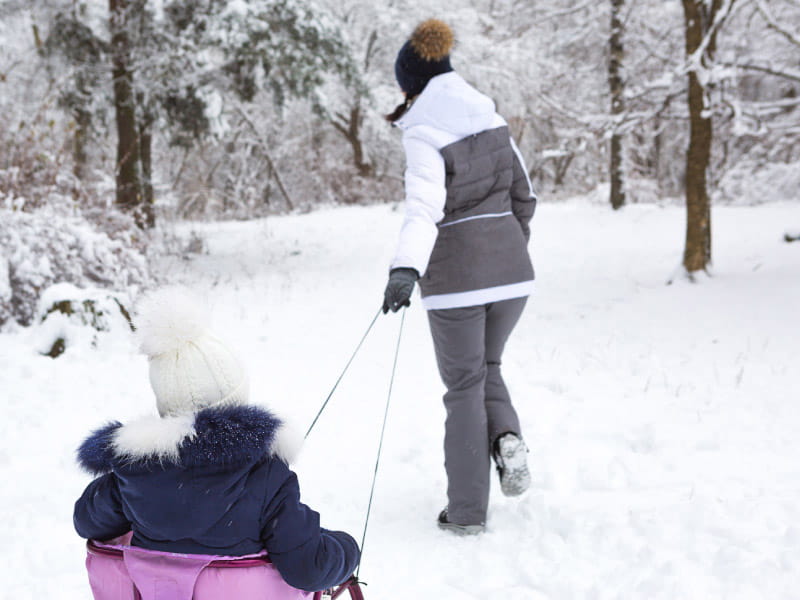You don't have to be an Olympian to find exercise thrills in winter's chill
By Michael Merschel, American Heart Association News

Watching what Olympic athletes can do on snow and ice might have you thinking about trying some cold weather activity yourself. And a glance at the thermometer might quickly have you saying, "nahhh."
Before you head back to the couch, know there are experts who say that not only can embracing winter be healthy, even cold-haters can find ways to cope. Some even find it … fun.
"I always say that it'll feel cold for probably the first five minutes," said Beth Lewis, a professor and the director of the University of Minnesota's School of Kinesiology in Minneapolis. "In fact, if it doesn't feel cold for the first five minutes, you probably are overdressed. But after that, it will feel absolutely wonderful."
Cold weather exercise might have particular benefits. Research suggests that cold aids the conversion of energy-storing white fat into calorie-burning beige fat. And Lewis points to studies that say people who exercise outdoors get more mood benefits than people who exercise indoors.
Cold-haters might point to risks. In its guide to injury prevention amid winter workouts, the American College of Sports Medicine acknowledges several, including frostbite (if you're skiing, sledding, mountaineering or the like), hypothermia and snow blindness. Also avalanches. Which, for most of us, are probably not likely to be an issue.
For the temperatures most people face, proper clothing will be enough. "The only time I would say it's dangerous to be exercising outside is if you have ice," or if the temperature is lower than 25 below zero, or the wind chill is 35 below or worse, Lewis said.
Her own tolerance for an outdoor workout is not quite as extreme. "Zero degrees is my threshold for going outside," she said. "It used to be negative 10. But now that I've gotten older, I think I'm getting to be more of a wimp."
Her embrace of winter might make most non-Minnesotans look wimpy by comparison. It's also an example of how the biggest barrier to being active in the cold can be mental.
This is a specialty of health psychologist Kari Leibowitz. Before earning her doctorate from Stanford, she spent a year in Tromsø, Norway, 200 miles north of the Arctic Circle.
This was not an easy undertaking for Leibowitz, who grew up savoring summers at the Jersey shore.
"I was never a winter person and always felt kind of 'meh' about the whole season," she said. But when she started asking Norwegians about coping with the dread of winter, they said, "Why would we be afraid of winter? It's such a wonderful time of year!"
People in Tromsø don't see winter as limiting. "There's festivals during the winter," she said. "They're skiing. They're spending time outdoors. And they're finding the opportunities in the season."
Leibowitz now lives in San Francisco and teaches workshops on cultivating what she calls a "wintertime mindset." It is not, to be clear, about grim acceptance or denying serious problems such as seasonal affective disorder.
It is about embracing the possible. Which is what happened to her sister-in-law, a runner who refused to do so out in the New York winter.
After hearing Leibowitz, she saw that cold weather running has upsides. She's not as sweaty as in the summer, and the "refreshing" air helps her wake up. She now runs outside all winter, Leibowitz said. "And she loves it."
Cold does require preparation. She and Lewis both suggested dressing in layers, with a base layer that draws moisture away from the skin. Leibowitz recommends wool; Lewis prefers a polyester-cotton blend, which she said balances breathability and wicking ability.
A turtleneck seals heat better than a scarf, Lewis said, and a hat works better than a headband. Because winter days are short, have reflective or illuminated gear for being in the dark. She likes reflective suspenders, which can be pulled over whatever you wear.
Warm up inside before you step out, she said. "I always recommend that people do about five to 10 minutes of some squats or lunges or something." The biggest injury risk is if you're sitting around in the cold weather, then all of a sudden start doing something vigorous, she said.
If you really aim to emulate those Winter Olympians, don't rush to buy a lot of gear. "I'd recommend renting," Lewis said. Also, do research about what a sport requires. For example, if you want to try cross-country skiing, you'd need to find a destination with groomed trails.
Whatever the Olympics inspire you to try – have fun.
"A lot of times we forget about having fun when we exercise," Lewis said. "And doing those kinds of activities can bring that fun back."
And if you're trying something new, Leibowitz said, you don't have to attempt an Olympian feat your first time out. "It could be a walk around the block." Or even spending a few minutes on your porch, enjoying the cold air.
"You don't have to take this too seriously," she said. "You can just go out there and try to have a good time. Wear the right clothes. See what happens. See where it takes you."
If you have questions or comments about this story, please email [email protected].





